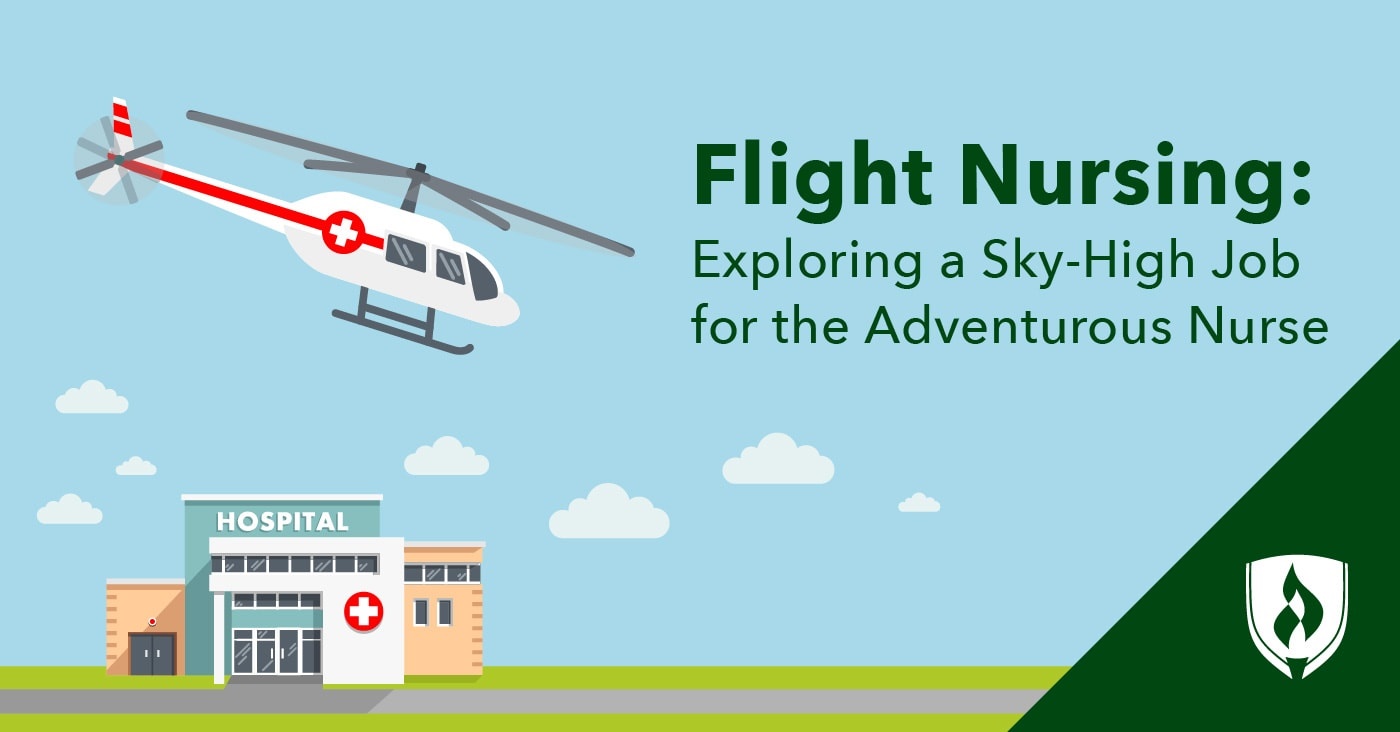Flight Nursing: Exploring a Sky-High Job for the Adventurous Nurse
By Carrie Mesrobian on 11/08/2021

It’s no secret the nursing profession is home to a wide variety of specialized roles. Whether they’re working in the operating room, emergency room, intensive care unit or at a pediatric specialty clinic (to name a few), nurses and their specialized roles and responsibilities can cover a lot of territory. But why stop with nursing roles planted on firm ground? There’s a lot of sky out there, and the flight nursing specialty offers a unique opportunity for nurses to provide patient care sometimes thousands of feet in the air!
If you’ve ever seen a hospital helicopter flying overhead and wondered what’s happening on board, you’re in the right place. We talked to the managing director of a flight nursing service to get insight into this subset of nursing—here, the sky’s anything but the limit when it comes to patient care.
What is flight nursing?
Flight nursing is a specialized nursing role that involves the care of patients being transported from one location to another, explains Bob Bacheler, a Doctor of Nursing Practice (DNP) and the managing director of Flying Angels, a worldwide non-emergency medical transport company.
“This can be by helicopter (rotor wing), air ambulance (fixed wing) or commercial airline,” Bacheler explains.
Though the field of medical transport has been around since the first World War, Bacheler says that flight nursing got its real start in the 1970s, incorporating medical evacuation lessons learned in the Vietnam War.
What do flight nurses do?
Flight nurses care for patients who are being transported. This can range from basic vital sign monitoring to providing emergency services, just like nursing care in a hospital—but it’s all done in motion and off the ground.
Patients getting flight nursing care include those being evacuated from a crash site or rescued from a remote area. Patients who must be transferred from one facility to another, oftentimes because another location has the proper staff and equipment to handle the patient’s needs, are airlifted by helicopter and cared for by flight nurses.
“Traditionally, hospitals have operated rotor-wing programs to supplement Emergency Medical Services for both the transport of critical trauma patients from accident sites and critically ill patients from one hospital to another,” Bacheler says. “The past twenty years have seen an increase in both private air ambulance companies, both rotor and fixed wing.”
How is flight nursing unique from other kinds of nursing?
Beyond the transport element, Bacheler says what makes flight nursing different from other types of nursing is the decision making involved.
“In many cases, flight nurses are the lead clinician treating their patients and making life or death decisions,” Bachler says. “In a hospital setting, the primary decision maker is usually a physician. In the transport environment, the flight registered nurse (RN) is the only person making the decisions impacting care.”
This is a high-stakes role where, like emergency room nurses, flight nurses need to think quickly on their feet to react to sudden changes in patient status. With limited options in the air, sometimes that requires flight nurses to focus on harm reduction and finding the “least bad” course of action.
How do you become a flight nurse?
Due to the high stress nature of the work, it’s no surprise that flight nurses often come from critical care or emergency nursing backgrounds.
“Nurses who wish to become flight nurses will want to seek out positions in intensive care units (ICUs) and/or Trauma Units,” Bacheler says.
Bacheler states that flight programs prefer nurses who have a Bachelor of Science in Nursing (BSN) degree as well as specialty certifications such as the Critical Care Registered Nurse (CCRN) credential and/or the Certification in Emergency Nursing (CEN) credential.
Many flight nursing organizations prefer five years of clinical experience and required certifications, including Basic Cardiac Life Support (BCLS), Advanced Cardiac Life Support Certificate (ACLS) and Pediatric Advanced Life Support (PALS).
The Board of Certification for Emergency Nursing (BCEN) also offers the Certified Transport Registered Nurse (CTRN) and Trauma Certified Registered Nurse (TCRN) certifications, which Bacheler says are also valuable to have for prospective flight RNs.
“Once one is working as a flight nurse, the BCEN offers the Certified Flight Registered Nurse (CFRN) which is one of the most coveted nursing certifications available to RNs,” Bacheler says.
“Upon being hired as a flight nurse, most programs will have both a didactic educational program and simulation environment training,” he adds.
Who would make a good flight nurse?
Given the level of decision making and the stakes involved, this specialty of nursing obviously requires professionals who self-select according to what they can handle.
“One of the important characteristics for any flight nurse, in any environment, is the ability to remain calm under extraordinary pressure,” Bacheler says. “Critical thinking in stressful environments is routinely required.”
In addition to being able to think on the fly, Bacheler says that flight nurses also need extensive knowledge of physiology and pharmacology in order to care for a variety of issues their patients might face.
Ready to have your nursing career take flight?
Whether you’ve got your sights set on working in the skies as a flight nurse or prefer to take on a more conventional nursing role, the reality is that this huge variety in nursing roles start from the same foundation—becoming a registered nurse. If you’d like to learn more about what that takes, start with our article “How to Become a Registered Nurse: Your 4-Step Guide.”
Related Articles:




